Unlocking Potential Through Digital Support Tools
Autism apps have become vital resources in supporting children with autism spectrum disorder (ASD). These applications facilitate learning, communication, emotional regulation, behavioral management, and daily routines, providing tailored and engaging solutions for diverse developmental needs. This article explores the purposes, features, types, and selection strategies for autism apps, highlighting specific tools like AutiSpark, and emphasizing their role in promoting skills and independence for children with ASD.
Understanding the Purpose of Autism Apps for Children
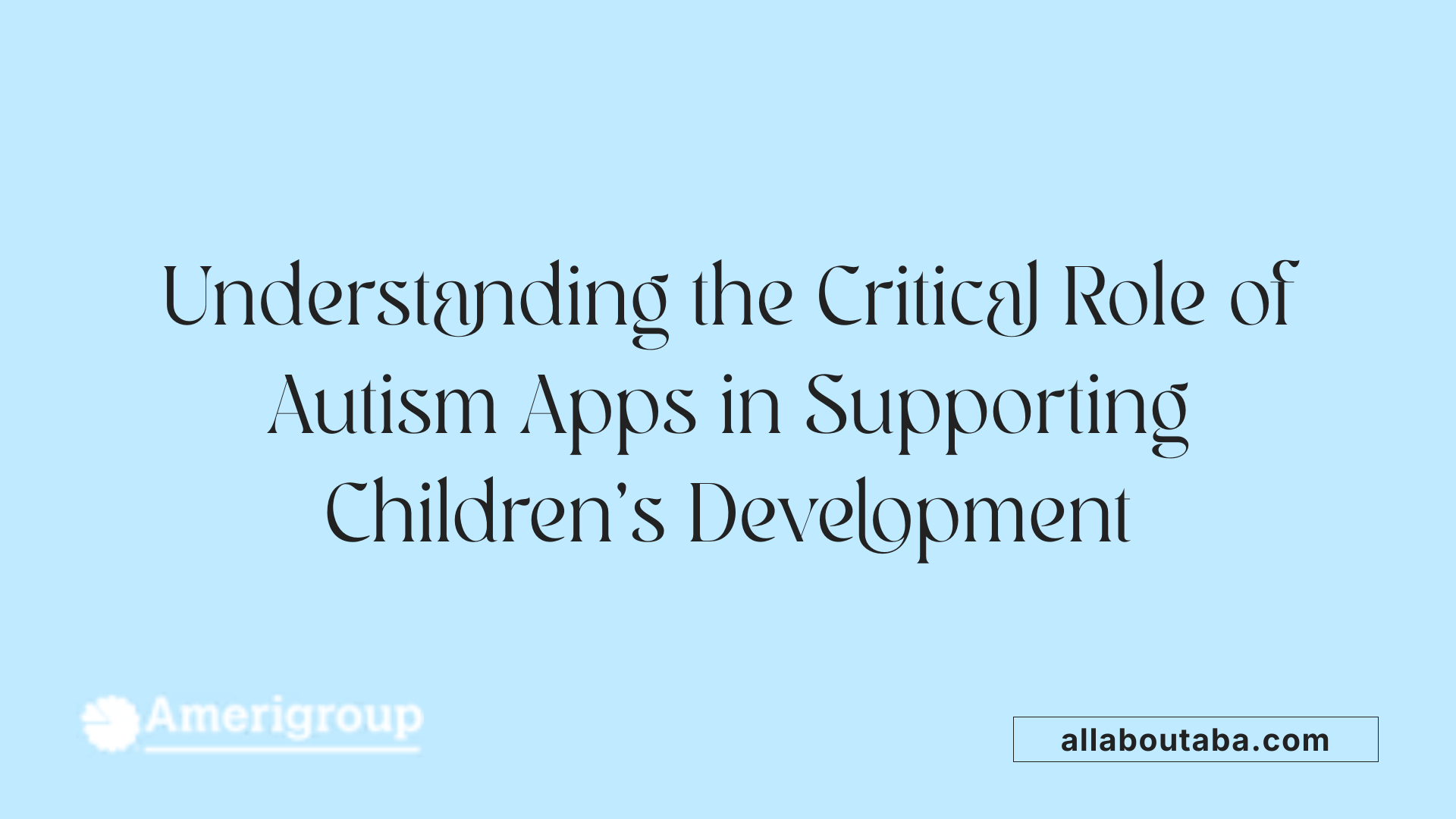
What are the main purposes of autism apps for children?
Autism apps for children are designed to support various aspects of development and daily living, tailored specifically to the needs of kids with autism spectrum disorder (ASD). These applications focus on enhancing communication, social skills, emotional regulation, and routine management.
One of the primary aims is to improve communication abilities. Many apps, such as Proloquo2Go and Avaz, serve as augmentative and alternative communication (AAC) tools, helping children express needs and feelings. Visual aids like social stories, visual schedules, and emotion recognition exercises teach children how to identify and express emotions, understand social cues, and engage more effectively with others.
Daily routines and behavior management are also supported through apps like First Then Visual Schedule and My Video Schedule. They help children stay organized, reduce anxiety related to transitions, and manage bedtime or other routines using visual supports.
Sleep apps such as White Noise, Go To Bed, and SleepBot assist children who face sleep difficulties, promoting better sleep hygiene. Some apps target specific challenges during puberty or stress management, like Planet Puberty or Stress Autism Mate.
The overall goal of these tools is to foster independence, emotional understanding, social interaction, and adaptive skills. Many reputable organizations review and recommend apps based on their evidence-based effectiveness, ensuring they meet professional standards.
In summary, autism apps serve as supportive aids that promote learning, emotional regulation, social skills, and independence. They are versatile tools tailored to individual needs, helping children with ASD navigate daily life more confidently and comfortably.
Features and Functionalities of Autism Support Apps
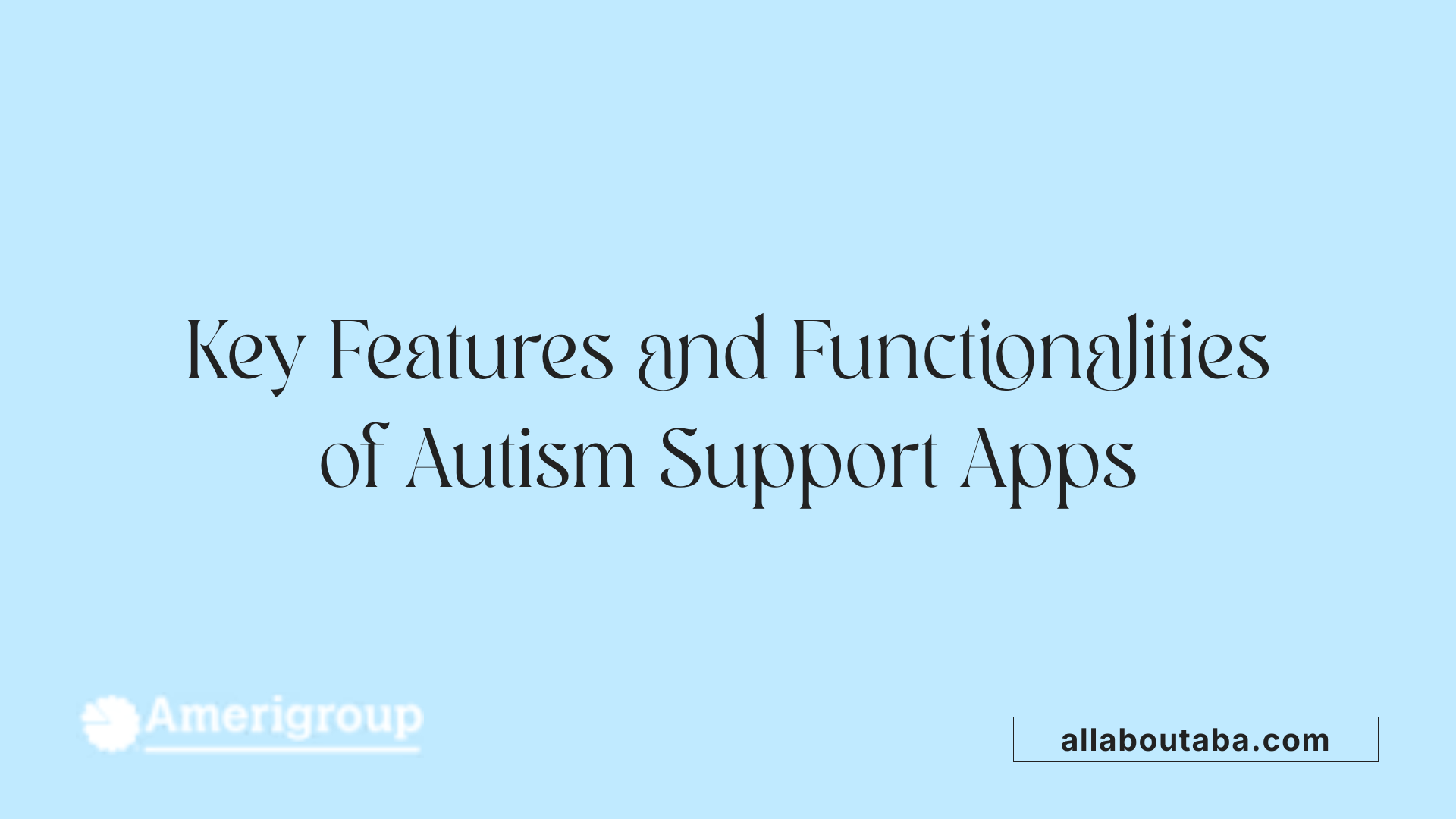 Autism support apps are designed to provide tailored assistance across a variety of developmental areas for children with autism spectrum disorder (ASD). These apps typically include a combination of visual communication tools, speech aids, routines, and interactive activities that cater to individual needs.
Autism support apps are designed to provide tailored assistance across a variety of developmental areas for children with autism spectrum disorder (ASD). These apps typically include a combination of visual communication tools, speech aids, routines, and interactive activities that cater to individual needs.
One primary feature involves visual communication tools that help children understand and express themselves better. For example, apps like Proloquo2Go and Pictello utilize picture-based symbols and storytelling to support communication. Speech and language aids often include augmentative and alternative communication (AAC) systems, aiding children who have speech difficulties to develop their language skills.
Social stories and routines are another highlight. Apps such as First Then Visual Schedule HD and Social Story Creator help children learn daily routines and social expectations through visual schedules and guided stories, reducing anxiety and promoting independence.
Emotion recognition exercises are embedded in many apps like Autism Emotion and Draw Emotions. These tools teach children to identify, understand, and express feelings, which are vital skills for emotional regulation and social interaction.
Structured routines and timers are incorporated into apps such as My Video Schedule and Visual Schedule Apps. These features help children manage their time effectively and adhere to daily schedules, which is especially beneficial for children needing predictability.
Interactive games and skill-building activities form a core part of many autism apps, including AutiSpark and Brain Parade's Autism & PDD Social Stories. These activities include matching, sorting, puzzle-solving, and memory games designed under the guidance of therapists to boost cognitive, social, and motor skills.
Some apps also focus on stress management and emotional regulation, incorporating calming sounds (White Noise) and timers (SleepBot) to promote better sleep and reduce anxiety.
Overall, these apps combine educational content, behavioral reinforcement, and emotional support, making them versatile tools that help children with autism develop essential life skills and improve their quality of life.
Types of Autism Apps Focused on Behavior, Emotions, Social Skills, and Sleep
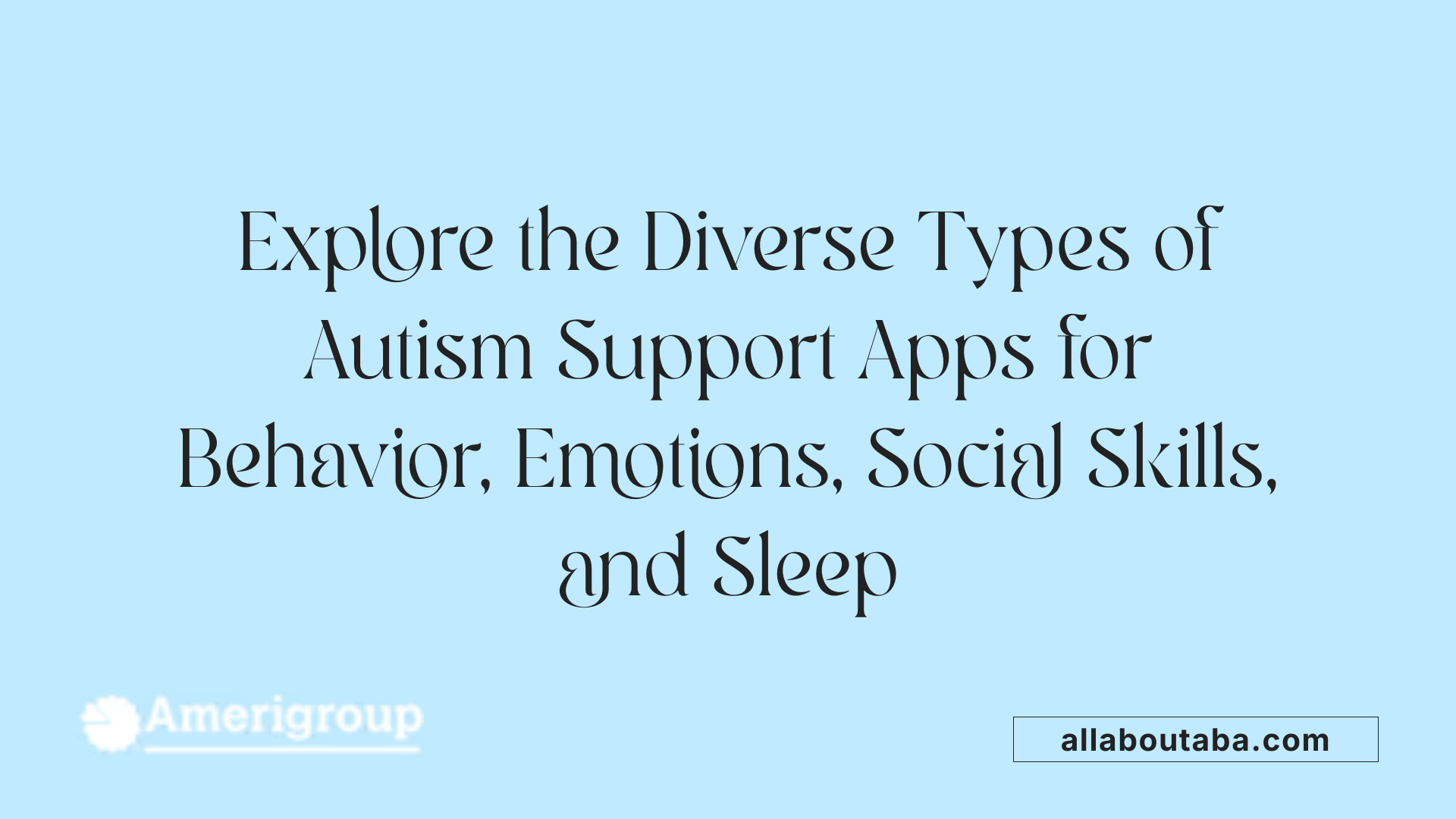 Autism spectrum disorder (ASD) presents unique challenges that often require specialized tools to support children’s development across different domains. Several app types are designed to address specific needs related to behavior, emotional understanding, social interaction, and sleep routines.
Autism spectrum disorder (ASD) presents unique challenges that often require specialized tools to support children’s development across different domains. Several app types are designed to address specific needs related to behavior, emotional understanding, social interaction, and sleep routines.
For managing behavior, apps such as 'Behavior World', 'Birdhouse for Autism', and 'Behavior Tracker Pro' are frequently used. These apps help caregivers and children track behavioral patterns, promote positive reinforcement, and develop routines that reduce distress and improve self-regulation.
Emotion recognition and expression are crucial skills fostered through apps like 'Autism Emotion', 'Draw Emotions', 'I Know How You Feel', and 'Touch and Learn - Emotions.' These applications employ multimedia and interactive exercises to teach children how to recognize facial expressions, understand different emotions, and express their feelings appropriately.
Developing social skills is supported by apps such as 'Social Success', 'The Social Express II', 'Conversation Builder', and 'Stories 2 Learn.' These tools provide simulated social scenarios, social stories, and role-playing opportunities that help children improve communication, understand social cues, and navigate interactions with peers.
Sleep difficulties are common among children with ASD. Sleep apps like 'White Noise', 'Go To Bed', and 'SleepBot' help establish calming bedtime routines, reduce anxiety around sleep, and track sleep patterns to identify issues and improve sleep quality.
Choosing the right app depends on individual needs and developmental goals. Many of these tools are designed in collaboration with professionals, ensuring evidence-based approaches. By integrating these apps into daily routines, caregivers can support their children in developing essential skills across behavior management, emotional intelligence, social interaction, and sleep hygiene.
| App Type | Examples | Functionality Description |
|---|---|---|
| Behavior management | 'Behavior World', 'Birdhouse for Autism', 'Behavior Tracker Pro' | Track behaviors, reinforce positive habits, and create routines |
| Emotion recognition | 'Autism Emotion', 'Draw Emotions', 'I Know How You Feel' | Teach children to recognize and express emotions |
| Social skills | 'Social Success', 'The Social Express II', 'Stories 2 Learn' | Enhance social understanding and communication skills |
| Sleep support | 'White Noise', 'Go To Bed', 'SleepBot' | Establish sleep routines and monitor sleep quality |
These targeted applications, developed with input from professionals and tested for effectiveness, serve as valuable tools in supporting children with ASD through customized and engaging methods.
Guidelines for Selecting Appropriate Autism Apps
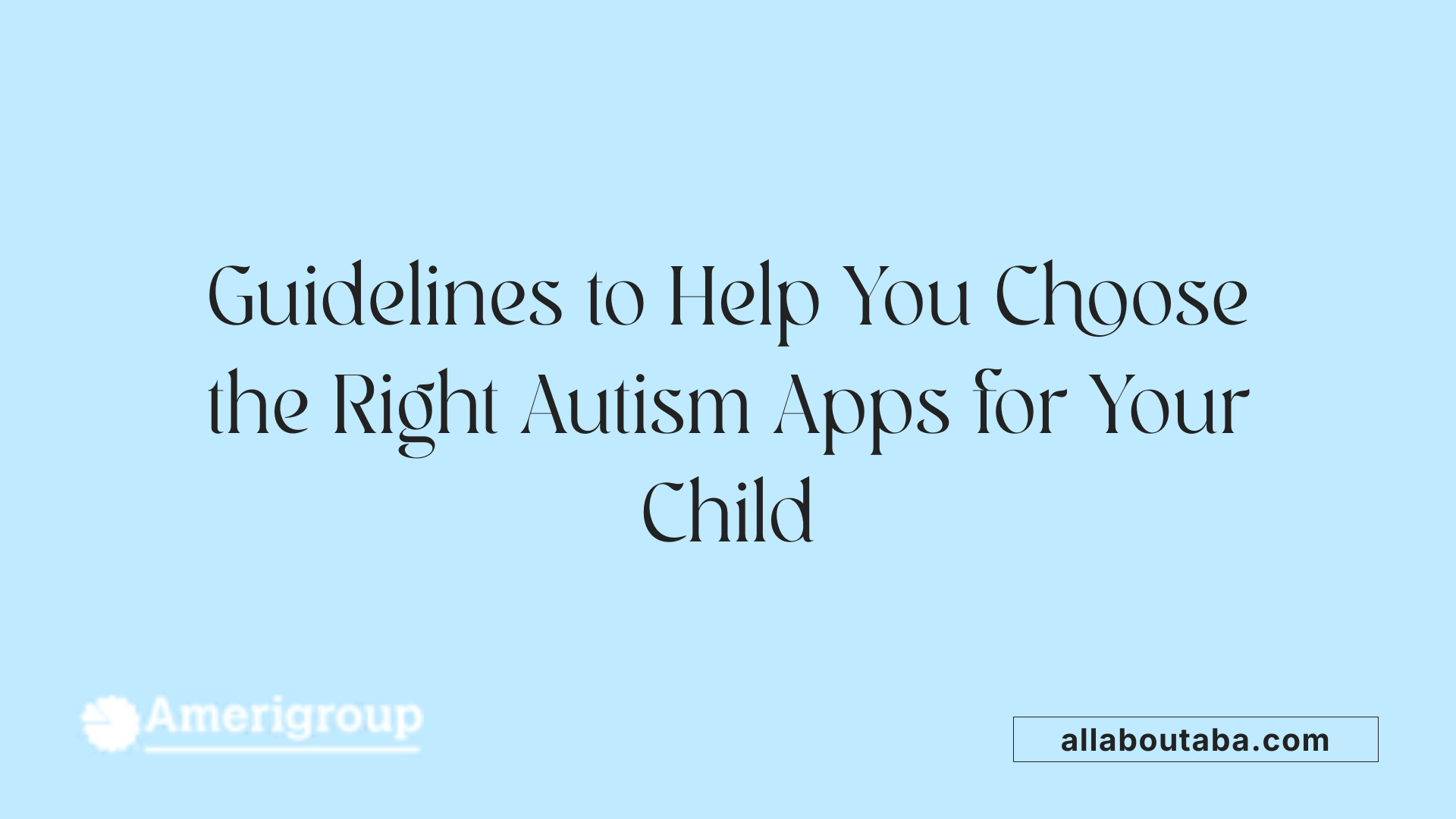 When selecting the right apps to support children with autism spectrum disorder (ASD), it’s essential to consider the child’s individual needs and developmental stage. Each child’s skills, interests, and challenges differ, so carefully matching an app’s purpose to those specific factors can maximize benefits.
When selecting the right apps to support children with autism spectrum disorder (ASD), it’s essential to consider the child’s individual needs and developmental stage. Each child’s skills, interests, and challenges differ, so carefully matching an app’s purpose to those specific factors can maximize benefits.
Begin by researching reputable sources like Autism Speaks, Bridging Apps, or the Vanderbilt Kennedy Center. These organizations review and recommend apps based on evidence and clinical effectiveness, focusing on areas such as emotional regulation, communication, social skills, routines, and learning. Websites often offer curated lists and detailed evaluations to assist caregivers and educators in making informed choices.
User reviews and app ratings provide additional insight into usability and engagement. Look for apps with positive feedback from other parents, teachers, and therapists, indicating that the app is accessible, motivating, and functional across different devices.
Consultation with professionals — including speech-language pathologists, occupational therapists, or educators — is a valuable step. These experts can advise on selecting apps that align with therapy goals and how to incorporate them into daily routines effectively.
Finally, ensure the app is compatible with the devices the child uses. Test its ease of use, readability, and accessibility features. An app that is too complex or not suited to a child's device may hinder engagement rather than foster it.
In essence, choosing the right autism app involves a thoughtful process that takes into account individual needs, credible resources, user experiences, professional advice, and device compatibility. This approach helps create a supportive, effective learning environment tailored specifically to each child's development.
Educational and Developmental Benefits of Autism Apps
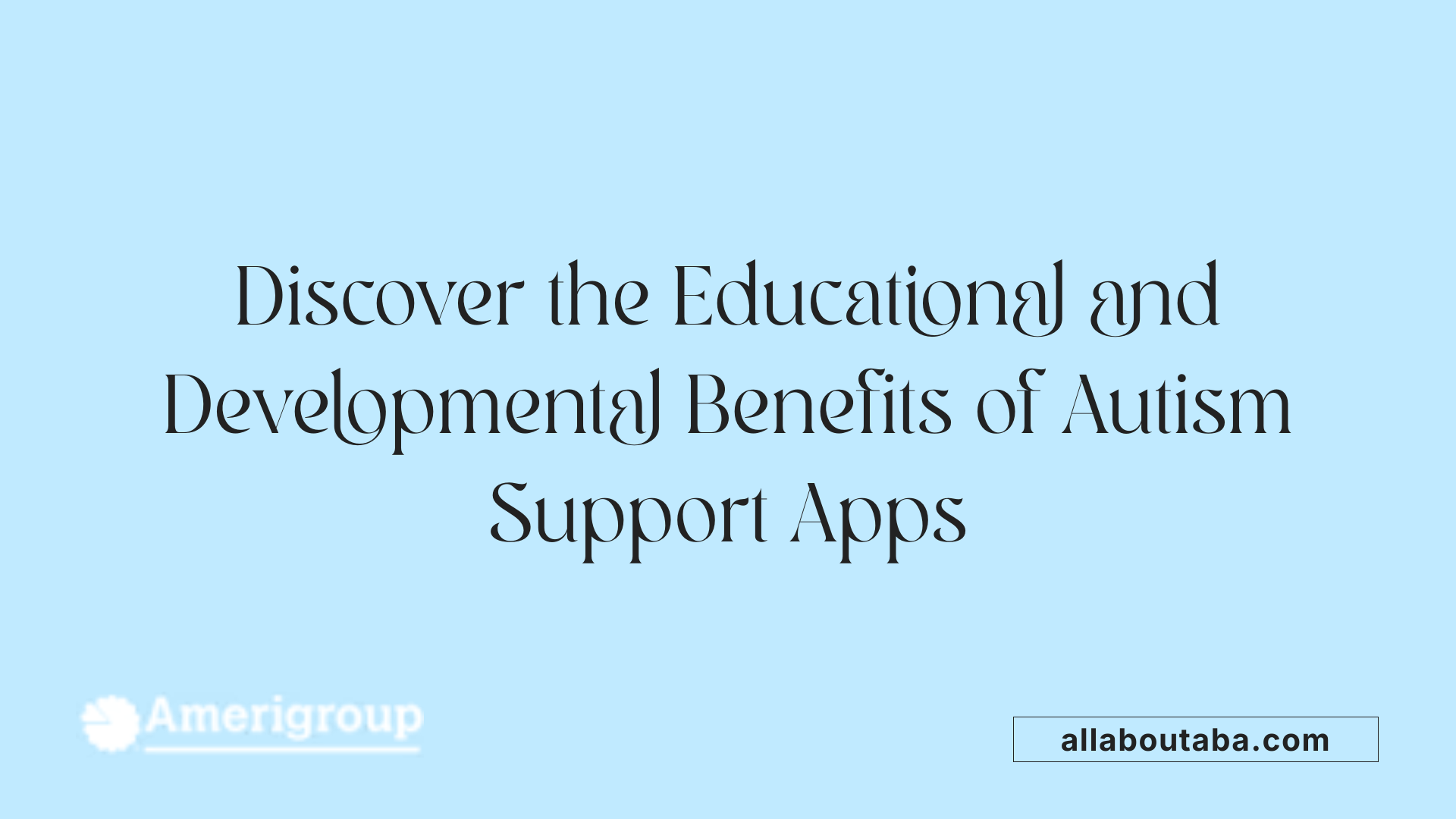 Autism apps provide numerous advantages that support children's growth across several important areas. These digital tools are especially valuable in helping children improve their communication skills. For example, apps like Proloquo2Go and Avaz assist with speech development and facilitate expressive language, making it easier for children to share their thoughts and needs.
Autism apps provide numerous advantages that support children's growth across several important areas. These digital tools are especially valuable in helping children improve their communication skills. For example, apps like Proloquo2Go and Avaz assist with speech development and facilitate expressive language, making it easier for children to share their thoughts and needs.
In addition to communication, these apps also underpin language and literacy growth. They include activities such as recognizing words, matching sounds to images, and basic reading exercises, which contribute to building foundational literacy skills.
Supporting social skills is another critical benefit. Many apps incorporate features that teach children to recognize emotions, practice social interactions, and understand social cues. For instance, apps like Autism & PDD Social Stories and Draw Emotions help children identify and express feelings appropriately, fostering better peer interactions.
Routine adherence and independence are also promoted through visual schedules and task management apps like My Video Schedule and First Then Visual Schedule HD. These tools help children become more autonomous by guiding them through daily routines, reducing anxiety, and increasing their ability to manage tasks independently.
Furthermore, autism apps encourage cognitive and creative engagement. Games focused on sorting, memory, puzzles, and life skills—such as those found in AutiSpark or Emotionary—stimulate thinking, problem-solving, and creativity. This holistic approach not only enhances learning but also boosts confidence and motivation.
In summary, autism apps serve as versatile resources that foster educational growth, social interaction, emotional regulation, and independence by providing tailored, engaging, and accessible learning experiences for children with autism.
Supporting Communication and Social Skills Development Through Apps
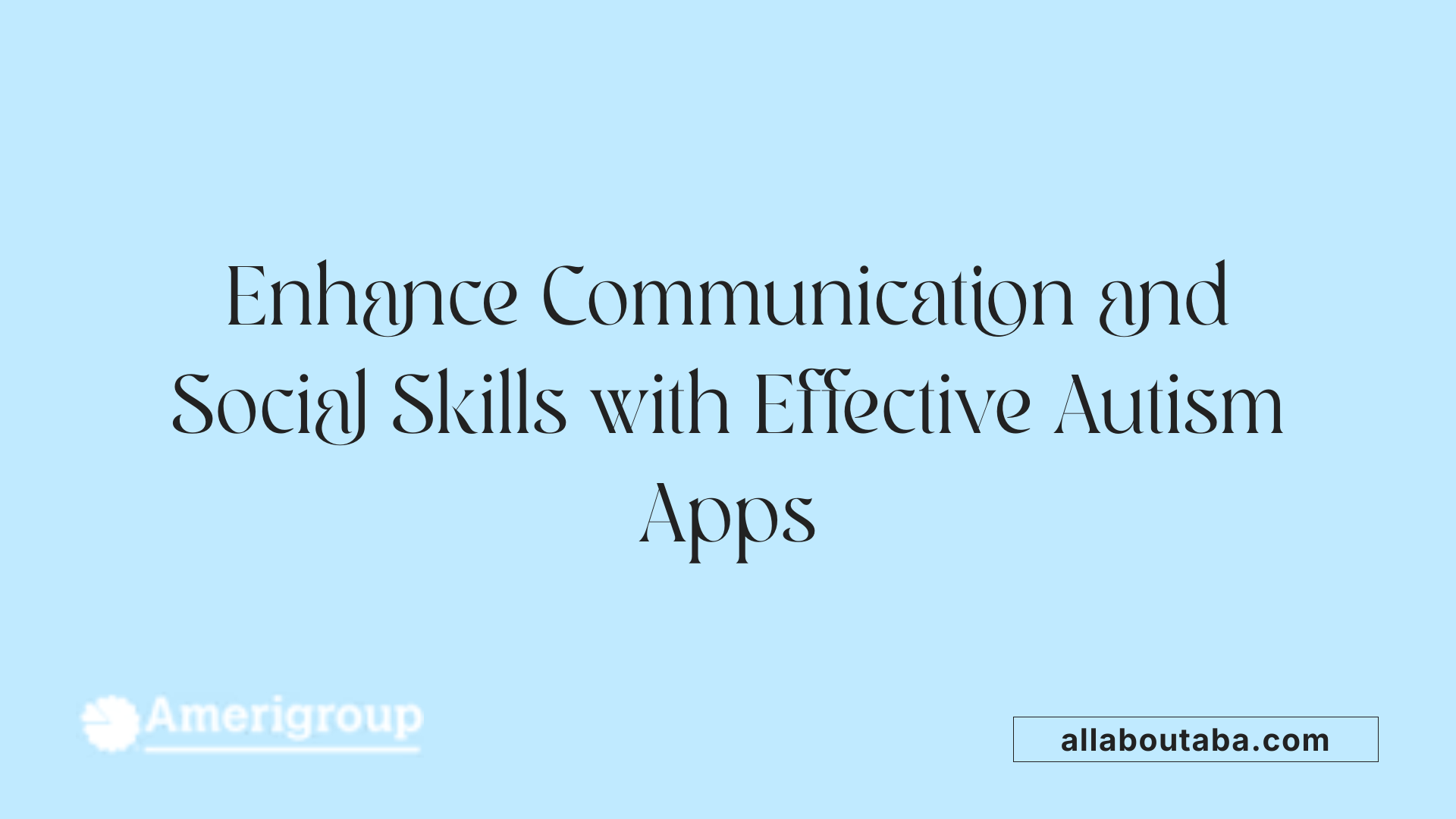 Autism apps have become vital tools in fostering communication and social skills among children and individuals with ASD. Among the most prominent are symbol-based augmentative and alternative communication (AAC) apps, which use visual symbols to facilitate expression.
Autism apps have become vital tools in fostering communication and social skills among children and individuals with ASD. Among the most prominent are symbol-based augmentative and alternative communication (AAC) apps, which use visual symbols to facilitate expression.
Proloquo2Go is a leading example, offering a customizable interface with a vast vocabulary, text-to-speech features, and options for multiple languages. This app enables non-verbal users to communicate effectively in various settings. Otsimo provides accessible visual communication tools and vocabulary games designed to encourage both interaction and understanding.
Personalized communication boards are also popular, with apps like MyTalkTools Mobile allowing users to create tailored boards filled with images, symbols, and audio clips. These can be integrated into messaging platforms, making daily communication more manageable. For teaching social skills, visual supports such as social stories are highly effective.
Pictello and First Then Visual Schedule HD are two apps that utilize visual storytelling to help children understand social cues, routines, and emotional responses. They assist in teaching social stories, which are essential tools for developing empathy and social understanding.
Role-playing through app-based scenarios offers another avenue for social learning. Many apps simulate real-life situations, guiding children through interactions and helping them practice appropriate responses. This approach supports the development of conversational skills and emotional regulation.
Various apps incorporate these features—visual supports, personalized boards, and social scripts—creating a comprehensive platform for developing communication and social skills in children with autism. This integration of visual tools and interactive simulations helps make complex social concepts accessible and engaging.
Resources and Lists of Autism-Related Apps for Stakeholders
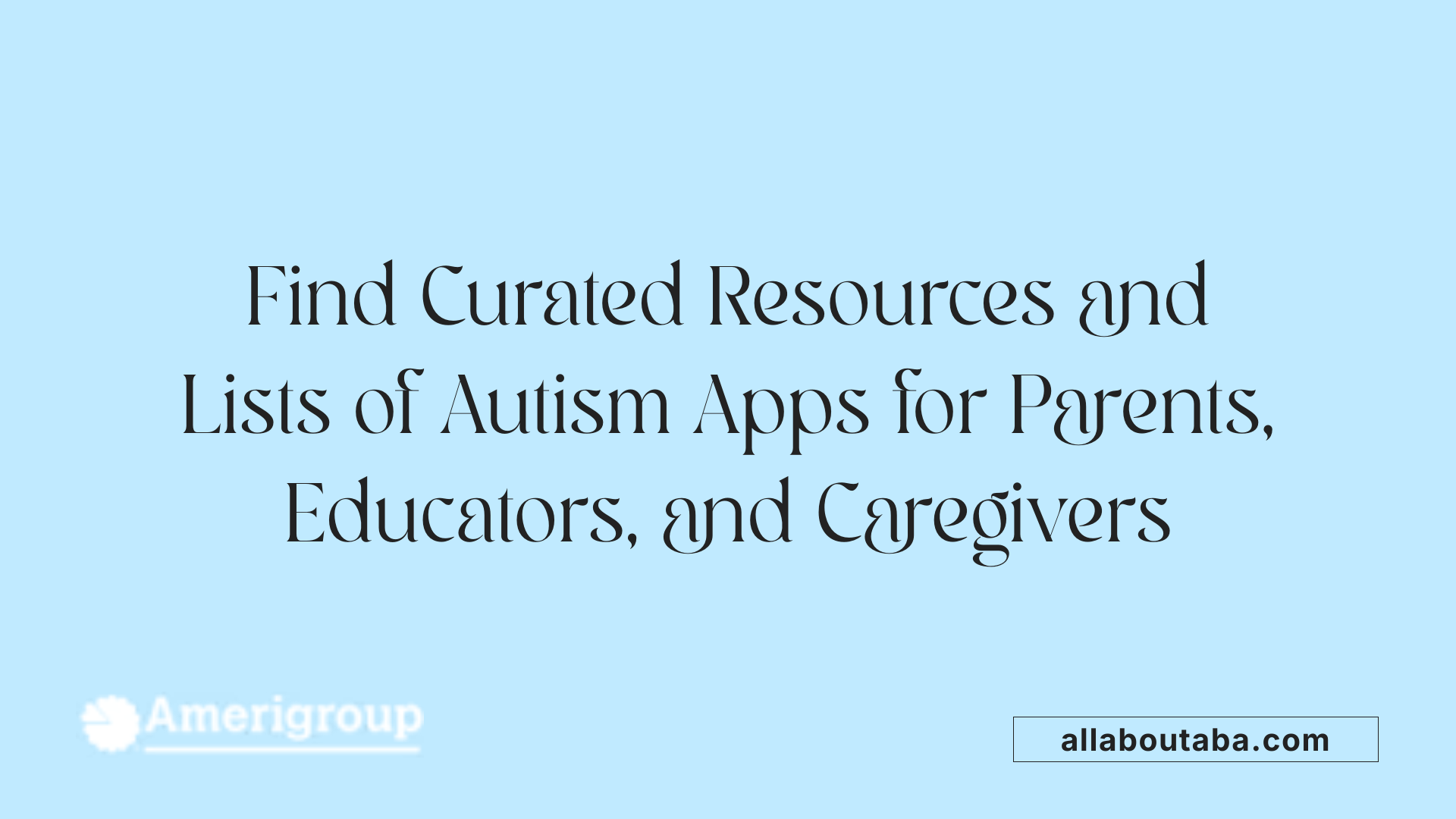
Are there resources or lists of autism-related apps available for parents, caregivers, and educators?
Yes, there are many curated resources and comprehensive lists designed to help parents, caregivers, and educators find suitable autism apps. These compilations often include applications that support social skills, communication, emotional recognition, routines, and daily management.
Several reputable websites and organizations serve as hubs for discovering effective autism apps. For example, Autism Speaks and Vanderbilt Kennedy Center provide curated lists of apps aligned with evidence-based practices, including ABA and speech therapy techniques.
App stores like Apple’s App Store and Google Play also feature sections dedicated to educational and developmental apps for children with autism. These platforms often highlight popular and highly rated tools such as Proloquo2Go, AutiSpark, and Pictello, which cater to diverse learning needs.
Online resources and organizations
- Autism Speaks: Offers a list of recommended apps tailored for different skill areas.
- Vanderbilt Kennedy Center: Provides resources and reviews for autism-related educational tools.
- Children’s National Hospital: Shares helpful apps supporting emotional, social, and behavioral development.
- Organizations like Bridging Apps and Waterford.org: Offer evaluations and user reviews, making it easier for users to select appropriate apps.
Educational platforms and app stores
Many educational platforms and app stores provide direct links or downloadable resources, often with professional guidance. For instance, TeachersPayTeachers has teacher-reviewed lesson plans and activity sheets that can supplement app-based learning.
Support from professional communities
Autism advocacy and professional communities regularly review and recommend apps. These include Autism Speaks' Autism Apps Review, and platforms like The SLP Solution and the Indiana Resource Center for Autism. Their evaluations ensure that the suggested apps are aligned with best practices and tailored to support the varied needs of individuals with autism.
These resources collectively serve as valuable tools to enhance learning, communication, and daily living skills for children and adults with ASD, making them accessible for everyone involved in their care and education.
Empowering Children with Autism Through Technology
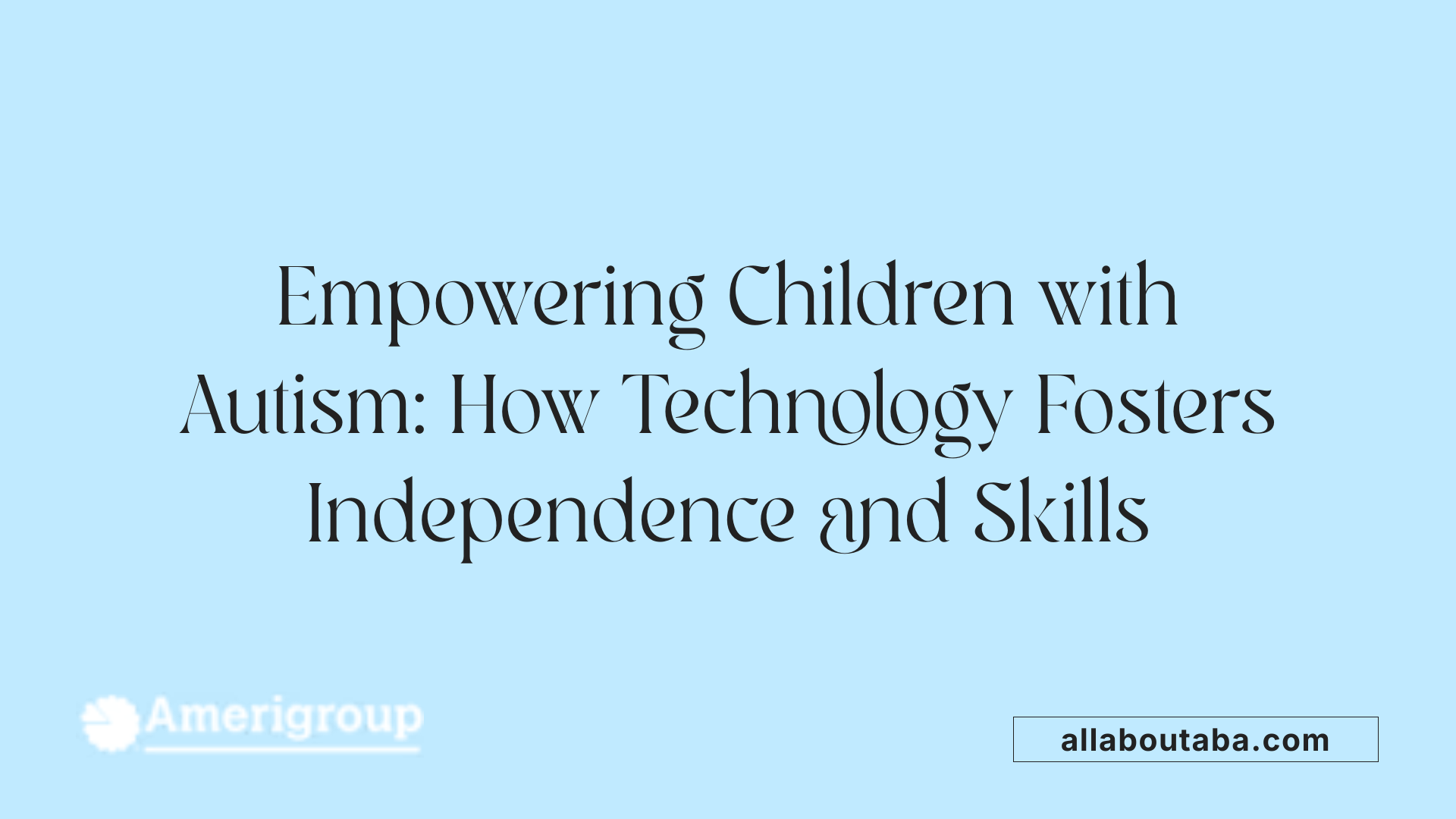
How can autism apps assist in learning, communication, and life skills development for children with autism?
Autism apps have become valuable tools in supporting children with autism spectrum disorder (ASD) by providing tailored, engaging activities that foster the development of essential skills. These digital resources enhance learning through visually stimulating content, such as colorful graphics, interactive animations, and story-based social stories that help children understand social cues, emotions, and routines.
Many apps incorporate augmentative and alternative communication (AAC) features, such as symbol-based communication boards and speech-generating tools like Proloquo2Go and Avaz. These assist children in expressing their needs, desires, and feelings, promoting verbal and non-verbal communication skills.
In addition, apps like AutiSpark and All About Me offer educational games designed to teach basic concepts such as recognizing objects, sounds, and words, as well as foundational math and literacy skills. These apps often include errorless teaching approaches, providing a positive learning environment that reduces frustration and builds confidence.
Furthermore, apps focused on behavioral management and routine support—such as My Video Schedule and ChoiceWorks—help children understand and anticipate daily activities and transitions, cultivating independence and reducing anxiety.
When integrated into daily routines and combined with professional guidance, these apps do more than just facilitate learning; they motivate children by offering interactive, fun experiences that encourage active participation.
Motivation and engagement
The interactive nature of most autism apps keeps children motivated and engaged. Games that involve matching, sorting, memory, and storytelling stimulate curiosity and enthusiasm for learning. Features like colorful visuals, sounds, and instant feedback make the experience rewarding.
Independence and autonomy
Apps enabling routine management and self-monitoring, such as visual schedules and social stories, empower children to perform tasks independently. This fosters a sense of control over their environment and daily activities.
Supplementing traditional therapies
While professional therapies like speech therapy, behavioral therapy, and occupational therapy remain foundational, autism apps serve as excellent supplementary tools. They extend learning outside clinical settings, offering consistent practice and reinforcement.
Promoting lifelong skills
Beyond early development, these apps support ongoing skill acquisition in areas like emotional regulation, social interaction, and self-care. For example, 'Zones of Regulation' aids in understanding and managing feelings.
Integration with educational and home routines
Successful use of autism apps involves aligning them with educational goals and home routines. For instance, teachers and parents can use apps like Stories 2 Learn or Fidget tools to reinforce learning and behavioral goals, creating a consistent environment that promotes stability and progress.
Autism apps and their role in skill development
Apps such as Autism & PDD Social Stories, All About Me, Draw Emotions, and Social Success help children recognize emotions, navigate social situations, and develop empathy. They support a variety of skills—from basic communication to complex social interactions—making them versatile tools across different developmental levels.
| App Name | Focus Area | User Group | Notable Features | Supplementary Notes |
|---|---|---|---|---|
| AutiSpark | Educational, Skills Training | Children with ASD | Recognizing objects, emotions, math | Over 200 games, worksheets, errorless teaching |
| Proloquo2Go | Communication | Non-verbal children | Speech-generating, AAC | Widely used therapy support |
| All About Me | Social and Personal Skills | Young children | Social stories, routines | Promotes independence |
| Zones of Regulation | Emotional Regulation | Middle childhood and above | Managing feelings, self-awareness | Supports lifelong emotional skills |
| My Video Schedule | Routine Management | All ages | Visual schedules, task sequencing | Reduces anxiety through predictability |
How can autism apps promote skills and independence?
By providing interactive content tailored to individual needs and developmental levels, autism apps promote independence. They encourage children to perform tasks like following routines, recognizing emotions, and communicating more effectively. Apps give children a sense of achievement, motivating ongoing engagement and skills mastery.
As these tools become integrated into daily life, children learn to self-regulate, navigate social situations, and perform routine activities with less adult intervention. This gradual increase in autonomy is crucial for building confidence and preparing children for more complex social and life challenges.
In summary, autism apps serve as powerful complements to traditional therapies, fostering motivation, enhancing learning, and supporting independence—helping children with ASD achieve meaningful developmental progress.
Harnessing Technology for Growth and Independence
Autism apps serve as vital tools that complement traditional therapies and educational strategies, offering children with ASD personalized, engaging, and effective support for their development. Their features encompass communication aids, behavior management, social skills training, routines, and emotional regulation, all tailored to meet individual needs. Reputable resources and expert-reviewed apps like AutiSpark exemplify how technology can unlock a child's potential, fostering greater independence and quality of life. As technology continues to evolve, so too will the opportunities for children with autism to learn, communicate, and thrive in inclusive environments—making autism apps an indispensable part of modern supportive practices.
References
- Helpful Apps and Websites - Autism Spectrum Disorders Clinic
- Autism apps | Healthify
- Kids Autism Games - AutiSpark on the App Store - Apple
- Best Autism Apps for kids on iPad, iPhone and Android in 2024
- AutiSpark - Games for Kids with Autism Spectrum Disorder (ASD)
- Best Apps for Kids with Autism | Common Sense Education
- AutiSpark: Kids Autism Games - Apps on Google Play
- Helpful Apps and Websites - Autism Spectrum Disorders Clinic







